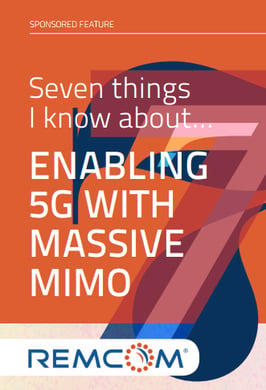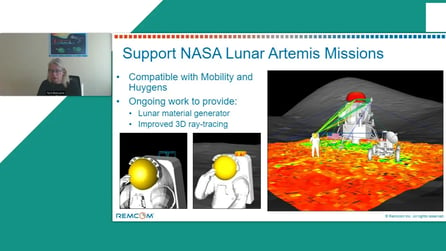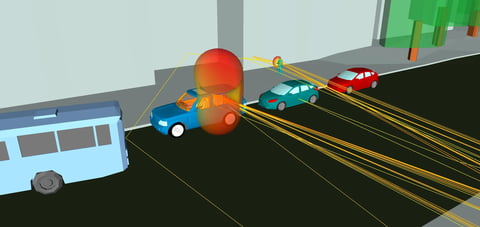Enabling 5G With Massive MIMO
 Summary:
Summary:
In this interview from The Mobile Network, Remcom discusses how a new approach to Massive MIMO channel modeling will be key to success of 5G network rollouts and applications.
Although 5G standards are still being set and full adoption of standards is not scheduled until 2020, the process is further along than that timescale indicates. Much R&D has been focused on the propagation characteristics of radio technologies that will make up the 5G air interface, and the study of Massive MIMO in mmWave bands has formed a major part of that drive. In this article from The Mobile Network magazine, Remcom experts discuss how a new approach to Massive MIMO channel modeling will be key to success of 5G network rollouts and applications.
1. 5G is closer than you may think
Although 5G standards are still being set and full ITU adoption of IMT-2020 standards is not scheduled until 2020, the process is further along than that timescale indicates. 3GPP is targeting the first freeze of New Radio standards later this year, and there has been a huge amount of R&D in the area of new radio systems.
Much of that R&D has been in the study of the propagation characteristics of radio technologies that will make up the 5G air interface, and the study of Massive MIMO in mmWave bands has formed a major part of that drive.
2. Massive MIMO will be massive for 5G
With 5G, the industry is targeting the ability to connect 10-100 times more devices with 10-100 times higher data rates. That requires an increase in overall capacity of 1000x or more. There is also the desire to be able to meet an increasingly diverse set of use cases, from mobile devices moving around in dense urban areas to deployments of IoT devices such as sensors and connected cars.
Although a number of enabling technologies will be deployed, Massive MIMO will play an important part because of the gains it achieves in spectral efficiencies via spatial multiplexing and beamforming. By deploying hundreds of elements that can work together to direct beams to multiple individual users in the same frequency, Massive MIMO antennas have the ability to achieve an order of magnitude increase in capacities and the number of connected devices. For throughput and capacity growth and for the device density that IoT brings, Massive MIMO is going to be key.
3. But Massive MIMO also introduces more complexity
By using beamforming to direct signals in specific directions rather than radiating over an entire cell, Massive MIMO increases spectral efficiency and reduces interference, but it also introduces increased complexity.
Small cell densification entails base stations increasingly being placed within complex urban environments that are rich with multipath, with signals reflecting and diffracting from a number of surfaces. Beamforming requires characterization of the channel between each antenna at each end of the communications link, requiring substantially more channel state information as the number of antennas grows. And while Massive MIMO can be used effectively at any frequency, 5G brings new millimeter wave bands whose small wavelengths will make it easier for increasing numbers of antenna elements to be sited on one device. Thus, predicting how transmitted and received signals vary across closely-spaced antennas requires much more detailed simulation.
To maintain links to users in a small cell, a base station is continually updating information about the channel and calculating the best way to get a signal to each user. MIMO beamforming relies on “pilot signals,” which enable a base station to characterize a channel and use its large antenna arrays to direct a beam to a single user. Pilot signals from neighboring cells can introduce interference in the network, or pilot contamination, which can greatly reduce the performance of Massive MIMO beamforming.
4. Accurate channel modelling is critical to understanding that complexity
Channel modelling enables you to predict or understand the propagation environment between different devices. To understand how to assess the performance of Massive MIMO, operators and vendors will require very accurate modelling of how signals will reach users as they move around an environment, including complex factors such as high levels of multipath, signal and antenna polarizations, and details of the phase across an array of antennas. Predicting what signal is received in each use case is then used to assess the effectiveness of beamforming. You need to simulate beamforming taking in data that defines building materials, terrain, vegetation and other structures so you can simulate those different variables in high detail.
5. Current planning techniques will not cut it
In the past, operators and system designers may have got by with simplistic statistical or 2D channel models but for Massive MIMO we are now talking about a very detailed model to determine where and how signals are propagating, and how to deliver an actual beam to an individual device.
Looking for multipath can get very complex. In an urban area you may have a line-of-sight to a device with a direct path and also lots of other paths that signals will travel to get from one to another, each presenting different copies of the signal. In addition, the phase of each path and its variation between each element of the MIMO system is also very important to understanding the performance of a MIMO system. To meet this need, 3D ray tracing uses simulations to predict all of these effects in order to understand what channels look like for different scenarios.
6. Simulating actual 3D beamforming requires high detail
Massive MIMO predictive channel modelling requires a new level of detail, with a full 3D ray tracing model that captures all the 3D effects that are going on. However, out-of-the-box, most ray tracing models are not up to the task of computing multipath in detail for Massive MIMO, as it requires a simulation for each transmitting antenna in the array, which becomes too computationally intensive in the case of massive MIMO. Most solutions try to handle this by making simplifying assumptions, while we instead try to keep the details but optimize calculations to minimize their impact to the run times.
7. How Remcom meets that need
Remcom was first to market with MIMO channel modelling. In terms of its ability to model massive MIMO, our Wireless InSite solution is unique and out ahead of the market. It includes the full accuracy of its 3D ray tracing capabilities, but with advanced optimizations that are ready to run out-of-the-box. With simulation, it is generally accepted that there is a trade-off between speed and accuracy. With our approach to MIMO, you do not need to compromise — you can get accurate results without sacrificing performance.
Operators and equipment manufacturers moving their 5G trials forward can now do so with a modelling tool that will quickly and accurately enable predictive modelling of a key 5G technology enabler.
More resources related to 5G MIMO


